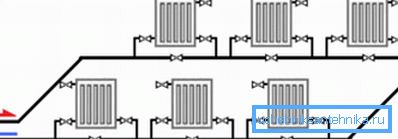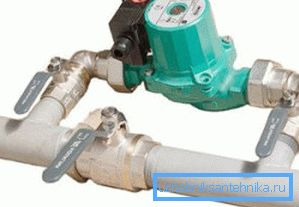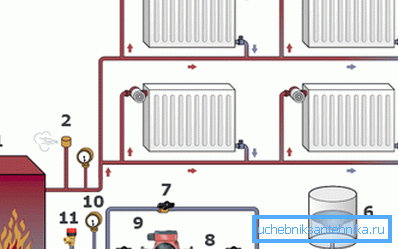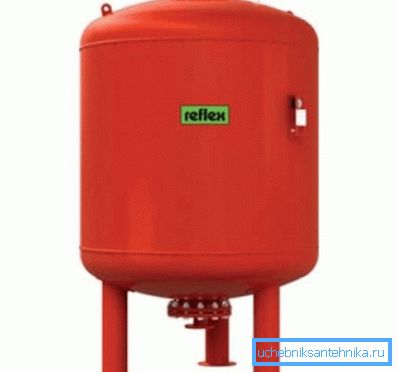Single-pipe heating system of a private house features and
A single pipe heating system is the simplest and most economical solution for private homes. However, in order for it to be really effective, before proceeding with its design, it is necessary to become familiar with some of the nuances and features of such heating. Therefore, in the following we will take a closer look at what this scheme represents and how one-pipe heating of a private house is done with our own hands.

Special features
The main difference of the system under consideration from the two-pipe one is that there is no separation of the main channels into direct and reverse. As a result, a closed heating circuit passes through the whole house along a specific path. At the same time, radiators are connected in series at the required points.
Temperature equalization in different rooms is carried out by changing the number of battery sections, as well as setting jumpers.
In addition, the following devices allow you to adjust the temperature balance:
- Thermostatic valve;
- Balancing valves,
- Radiator regulators or ball valves.
In general, the device of such a system is quite simple.
Merits
The considered scheme has many advantages, among which are:
- Economic design, as its installation requires much less pipes.
- Easy installation and repair.
- The ability to lay the pipeline above the floor or even under it.
- Possibility of realization both in the one-storeyed house, and in a structure with several floors. Moreover, a closed ring can cover even a large area of the house.
For these reasons, the scheme of a one-pipe heating system of a private house has become widespread.

disadvantages
Along with the advantages of one-pipe system has some disadvantages:
- It works inefficiently without forced circulation, carried out with a special pump.
- If you create pressure in the system with the help of the upper piping, you must use pipes with a larger diameter, the price of which is higher. In addition, communications can spoil the interior space. Therefore, from an aesthetic point of view it is better to hide the pipes under the floor.
- There is no possibility of adjusting the degree of heating of individual batteries (when mounted on a simple scheme).
In general, as we see, the disadvantages of such a scheme are not critical.

Ways to install radiators
In a one-pipe system, radiators can be connected in two ways. Therefore, before completing the installation of the structure, it is necessary to become familiar with the features of both options:
| Simple unregulated circuit | It has a minimum number of compounds and elements. Batteries in this case are connected at two points - at the input and at the output. As mentioned above, the disadvantage of this scheme is that it is impossible to disconnect one radiator. Because of the low efficiency and uneven heating of the batteries, such a scheme can only be used in small private houses. |
| Scheme "Leningrad" | It is a more advanced option - on the inlet and outlet of the radiators, cranes are mounted that allow separately shut off the heating devices or regulate their heating. |
Thus, the second scheme is more complex and costly, but it has important advantages, and therefore is more preferable. Especially it makes sense to use it in large houses.

Installation of one pipe system
Materials
In order to equip a single-pipe heating system in a house, the following materials and equipment should be prepared:
- Boiler required power.
- Circulation pump.
- Expansion tank open or membrane type.
- Pipes - 25 mm in diameter for highways and 20 mm for connecting batteries. For example, for these purposes you can use polypropylene pipes.
- Radiators.
- Fittings for pipes.
- Mayevsky's cranes for elimination of air from radiators and highways.
Note! To determine the amount of materials, it is first necessary to draw up a system design to scale.

Mounting technology
So, a brief instruction on the installation of heating is as follows:
- The first step is to install the boiler, according to its location in the diagram.
- Then the pipeline is mounted. In places where the batteries are connected, you should install tees, which will allow you to perform a bypass, as shown in the diagram.
- Next, in the selected place you need to install a circulation pump. Technically, the device can be connected to the main pipe at any place, however, as a result of limiting its maximum operating temperature, the pump should be located in the “coolest” place of the network.
- After this, an expansion tank is installed. If it is open, it should be located at the top, for example, in the attic. Membrane tanks can be installed anywhere, most often they are mounted near the boiler.
- Then radiators are connected to the system according to the project. Also at this stage, overlapping taps, plugs and Mayevsky taps are installed.
- The final stage is pressure testing with compressed air. After this, a test run of the system and its adjustment are performed.

Note! When installing a heating pipe with natural circulation, it is necessary to withstand a slope of 3-4 degrees. If the system involves the forced movement of the coolant, then the slope should be 1 cm per meter.
Here, perhaps, all the main points of installation of heating on a one-pipe scheme.
Conclusion
One-pipe heating system can be used for all types of private homes. The only thing you need to properly draft and avoid mistakes in the process of installation. From the video in this article, you can pick up some additional information on this topic.